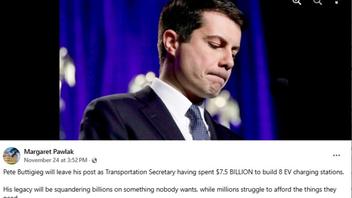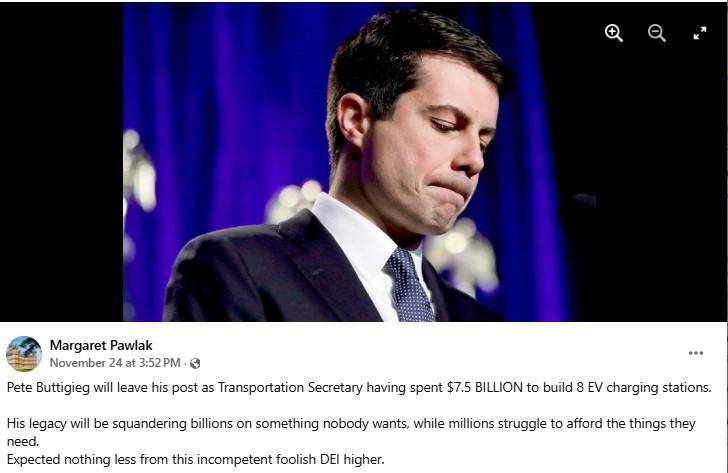STORY UPDATED: check for updates below.

Has the Department of Transportation under Secretary Pete Buttigieg spent $7.5 billion on only eight EV charging stations? No, that's not true: Much of the money set aside for the National Electric Vehicle Infrastructure Program has yet to be spent as states apply for grants to fund EV charging projects. According to the Federal Highway Administration, 214 charging ports have already been built with 24,800 more on the way.
The claim appeared in a November 24, 2024 Facebook post (archived here). It said:
Pete Buttigieg will leave his post as Transportation Secretary having spent $7.5 BILLION to build 8 EV charging stations.
His legacy will be squandering billions on something nobody wants, while millions struggle to afford the things they need.
Expected nothing less from this incompetent foolish DEI higher.
Here is how the post looked at the time of writing:
(Source: Facebook screenshot taken on Tue Nov 26 22:44:55 2024 UTC)
The $7.5 billion National Electric Vehicle Infrastructure (NEVI) Program is part of the $1.2 trillion Infrastructure Investment and Jobs Act (archived here), which passed with bipartisan support and was signed into law November 15, 2021.
NEVI's mission (archived here) is to create "a path to a nationwide network of 500,000 EV chargers by 2030 that ensures a convenient, affordable, reliable, and equitable charging experience for all users."
Buttigieg addressed the 8 EV charging stations claim on November 25, 2024, via a thread on his X account (archived here):
To start with, $7.5B has not been spent, nor anything like that. That's the entire program budget for the NEVI program, which is to help build out a national charging network by 2030.
Secondly, there are chargers now operational in nine states (which does not mean 9 chargers, to be clear). These are only the first handful though. Most are to be built in the 2nd half of the decade.
Third, in this program the chargers are built by the states, not the federal government. And while it takes time to get a novel multi-billion dollar program going across 50 states, the states are on track.
To recharge, an electric vehicle uses a connector at a charging port (archived here). A single charging station can have multiple ports available.
In a November 27, 2024, email to Lead Stories, a Federal Highway Administration spokesperson said NEVI so far has created 214 federally funded public charging ports across 12 states, and there are projects for 24,800 federally funded charging ports underway across the country.
The Infrastructure Investment and Jobs Act, also known as the Bipartisan Infrastructure Law, allows states to apply for grants to get reimbursed for the costs of setting up EV charging networks. The law spreads out the funding to a total of $1 billion each year (archived here) over five years for chargers built within one mile of an interstate highway. An additional $2.5 billion is set aside for other areas (archived here), such as downtowns or local neighborhoods.
In 2024, all 50 states plus Puerto Rico and the District of Columbia have submitted plans for EV charging networks to NEVI (archived here) and been awarded approval letters for eventual reimbursement.
According to the FHWA spokesperson, those approvals unlock nearly $2.5 billion to "fund the construction and operation of charging stations. This is not money spent, just money available to states to budget. States are in the driver seat to commit these funds to projects and spend at their discretion."
The program also reported funding the repairs of 4,471 existing broken charging ports at a cost of $148,792,909 (archived here).
For more Lead Stories fact checks on claims involving electric vehicles, click here.
For more Lead Stories fact checks on claims regarding Pete Buttigieg, click here.
Updates:
-
2024-11-27T17:06:30Z 2024-11-27T17:06:30Z Adds quote from Federal Highway Administration spokesperson.
















